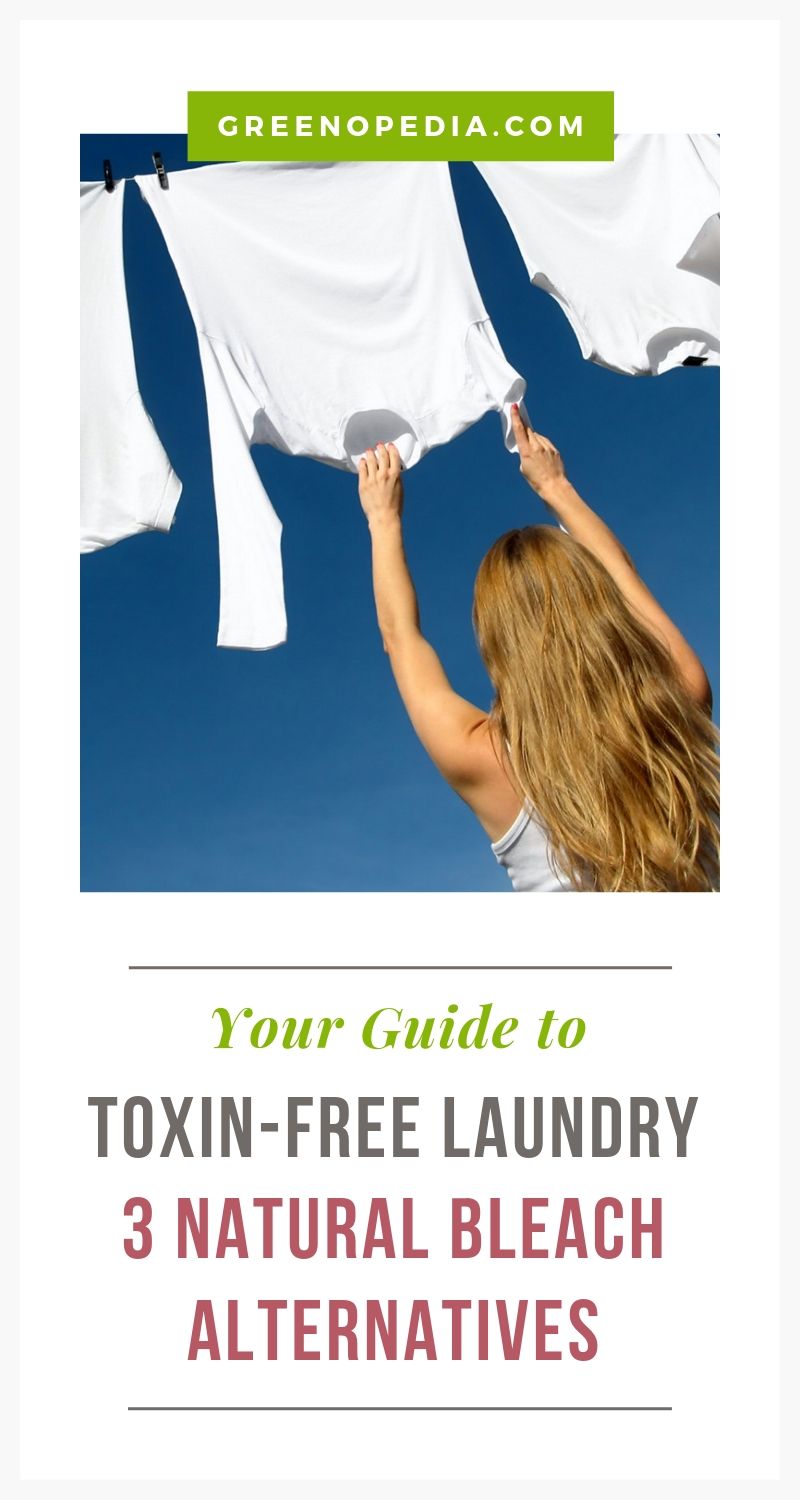Chlorine bleach does an amazing job of getting your dirty socks, tees, and washcloths white again. But like most chemicals that make our lives easier, bleach’s superpower comes at a price.
The harsh fumes from chlorine are dangerous to inhale and can lead to serious respiratory issues over time. The chemical residue also remains on clothing, towels, sheets and cloth diapers. These fabrics then rub against our bodies and can cause rashes and irritation for those with sensitive skin. Babies and children are especially susceptible to respiratory and skin irritations from chlorine bleach.
To whiten laundry naturally, replace chlorine bleach in the washing machine with white vinegar or non-chlorine oxygen bleach. You can also whiten your laundry while it’s drying with the cleanest, most powerful and lowest cost bleach of all: the sun.
Also read: The Clean Laundry Scoop on Natural Detergents, Softeners, and Whiteners
Oxygen as a natural bleach alternative
Natural oxygen bleaches provide a healthy alternative to harsh chlorine. The main ingredients – and sometimes the only ingredients – in oxygen bleaches are hydrogen peroxide (hydrogen + oxygen) and sodium carbonate, also known as “washing soda” or “soda ash”.
This natural alternative is as easy to use as chlorine bleach. Simply add 2 tablespoons of non-chlorine bleach alongside your regular detergent. Add your laundry and wash as usual. It really is that simple.
Plus, since you don’t need much, a bag of chlorine-free bleach goes a long way.
P.S. Did you know that hydrogen peroxide gets rid of mold better than bleach does?
Sun bleaching is free
Skip the dryer AND the harsh bleach with the most natural and cost-effective dryer and whitener there is – the sun!
Fabrics tend to whiten better in the sun when they are wet, so wash or wet items first. Hang wet laundry on a clothesline or drying rack. Or if you only have a few items, you can just lay them on a towel. Straighten any wrinkles as best you can, so the sun hits everything evenly. And only keep your laundry in the sun for 2-3 hours. Leaving them out for too long can weaken the fabric.
To boost the sun’s bleaching power, try mixing 1/3 cup lemon juice with 2 cups water into a spray bottle. Spray any dark stains or extra dingy items as soon as you hang them (i.e. while they’re still wet).
Especially dingy clothing or dark stains may require another sun-soak or two before fully whitening.
Tackling especially dingy whites
Sometimes a good washing with a bleach alternative isn’t enough. For extra dingy whites:
- Fill a large pot halfway with water
- Add one cup of distilled white vinegar
- Bring the pot to a rolling boil and then turn off the heat
- Carefully place the dingy items into the pot.
- Let them soak overnight and wash as usual.
This works really well for t-shirts, socks, cloth napkins, and dishcloths.
Also read: Remove Fabric Stains With Natural Ingredients You Already Have Handy
Good to know
- Vinegar and chlorine-free bleach aren’t just great at whitening whites — they also brighten colors. Still, you don’t want to mix your laundry, because the colors can bleed onto the whites.
- In liquid form, non-chlorine bleach is usually just a mix of hydrogen peroxide and water. In powdered form, it’s a mix of hydrogen peroxide, washing soda (sodium carbonate), baking soda (sodium bicarbonate) and/or other natural oxidizers.
- Hydrogen peroxide (H2O2) quickly breaks down into pure water (H2O) and oxygen (O2), so it is easily biodegradable. In fact, it is this fizzy release of oxygen that lifts wine, blood and yellow armpit stains without harming the fabric.
- Vinegar should not be used with PUL (polyurethane) diaper fabrics because the soft plastic fibers can degrade over time.
- Research
- http://eartheasy.com/live_nontoxic_solutions.htm
- http://toxnet.nlm.nih.gov/cgi-bin/sis/search/a?dbs+hsdb:@term+@DOCNO+547
- http://www.atsdr.cdc.gov/mmg/mmg.asp?id=304&tid=55
- http://www.atsdr.cdc.gov/toxfaqs/tfacts174.pdf
- http://www.dhs.wisconsin.gov/eh/chemfs/fs/chlorine.htm
- http://www.ecoevaluator.com/lifestyle/cleaning/vinegar-is-an-amazing-green-cleaner.html
- http://www.education.nh.gov/instruction/school_health/documents/disinfectants.pdf
- http://www.heinzvinegar.com/tips/laundry-room
- http://www.nlm.nih.gov/medlineplus/ency/article/002652.htm
- http://www.versatilevinegar.org/faqs.html
FREE DOWNLOAD
Natural Living Guide
Find practical tips & natural alternatives to the everyday chemicals that invade our lives.









